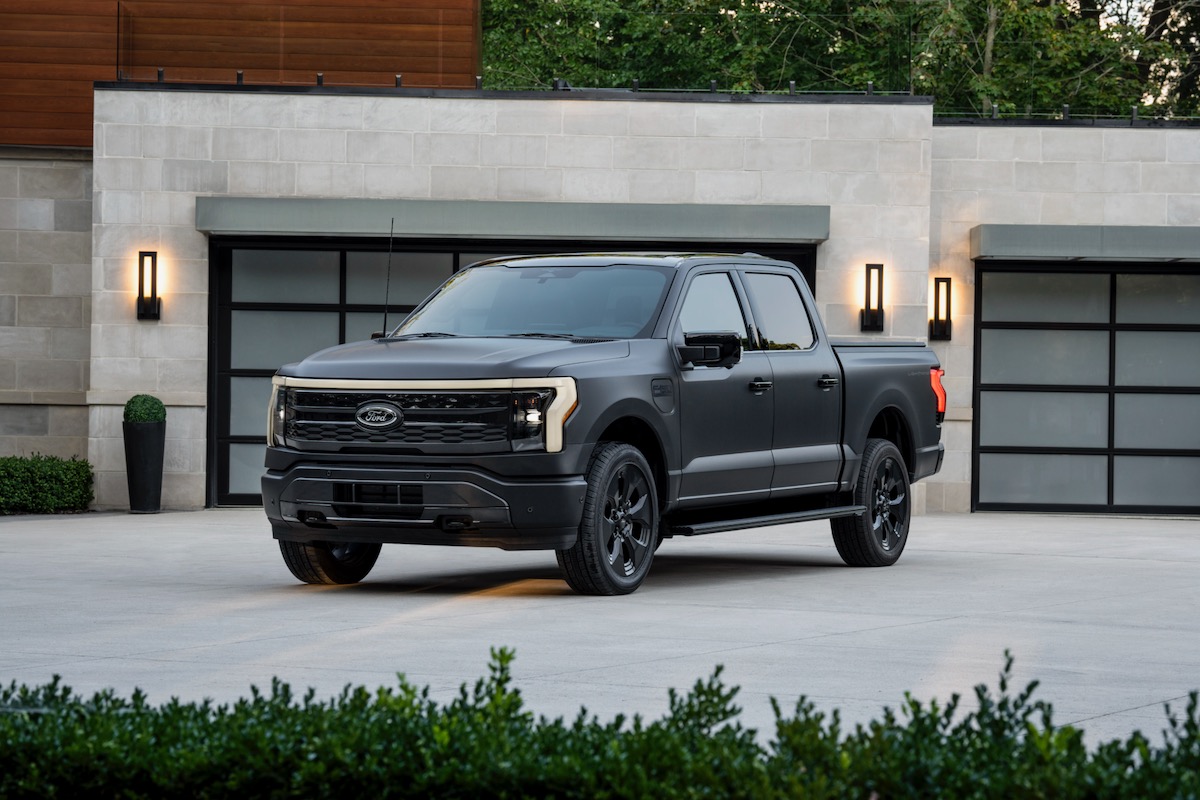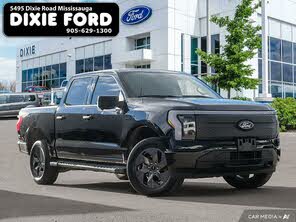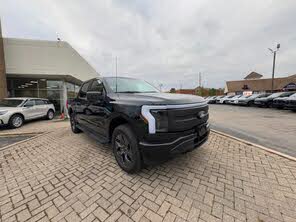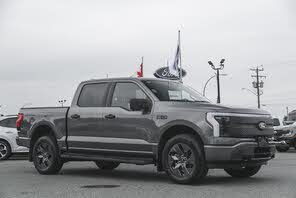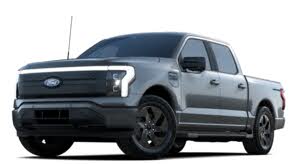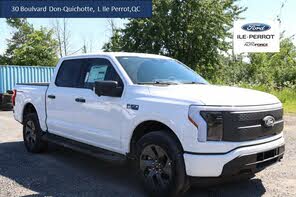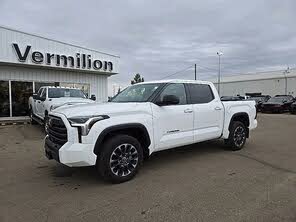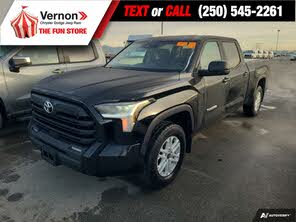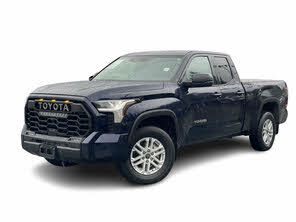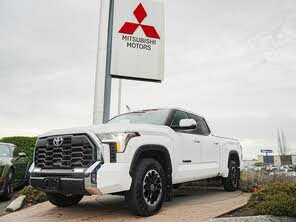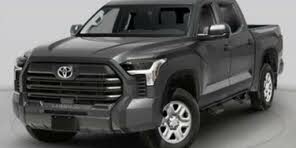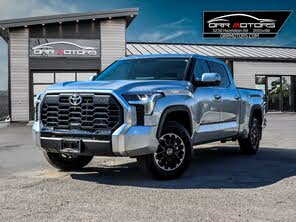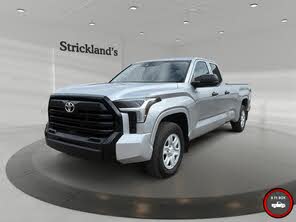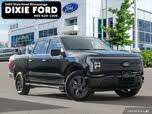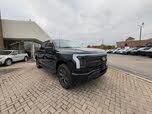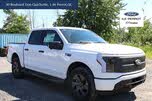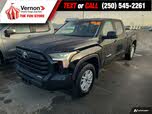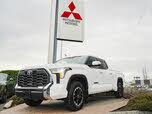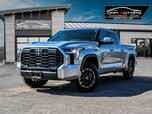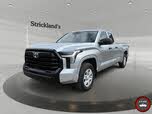2024 Ford F-150 Lightning vs 2023 Toyota Tundra
Overview | |
MSRP$38,965 | MSRP$54,995 |
Average price$58,022 | Average price$76,663 |
Listings93 | Listings343 |
Ratings & Reviews | |
User Reviews | User Reviews |
Expert reviews8.0 out of 10 | Expert reviews |
Pros
| |
2023 Toyota Tundra Reviews SummaryFor over twenty years, the Toyota Tundra provided the basics. A stout engine, a reliable platform, and the sort of performance and capability that truck buyers still seek today. But in the automotive industry, twenty years is a long time. Change is inevitable, but few vehicles see changes as dramatic as what the Toyota Tundra underwent between the 2021 and 2022 model years. As it turned over a new generation, the Tundra gathered a brand new look, a massively more modern powertrain, and a full technological makeover. For 2023, Toyota keeps things much the same. | |
2024 Ford F-150 Lightning Reviews Summary | |
No video found | |
Popular Features & Specs | |
Engine3.4L 348 hp V6 | Engine452 hp Electric |
Drive Train4X2 | Drive TrainAWD |
Seating Capacity5 | Seating Capacity5 |
Horsepower348 hp @ 5200 rpm | Horsepower |
EV Battery Capacity | EV Battery Capacity98 kWh |
MPG City18 | MPG City78 |
MPG Highway24 | MPG Highway63 |
Battery Charge Time (120V) | Battery Charge Time (120V)95 hours |
Battery Charge Time (240V) | Battery Charge Time (240V)15 hours |
Engine | |
Engine Name3.4L 348 hp V6 | Engine Name452 hp Electric |
Torque405 lb-ft @ 2000 rpm | Torque |
Horsepower348 hp @ 5200 rpm | Horsepower |
Battery Charge Time (120V) | Battery Charge Time (120V)95 hours |
Battery Charge Time (240V) | Battery Charge Time (240V)15 hours |
Drivetrain4X2 | DrivetrainAWD |
Fuel Economy | |
EV Battery Capacity | EV Battery Capacity98 kWh |
MPG City18 | MPG City78 |
MPG Highway24 | MPG Highway63 |
Interior | |
Seating Capacity5 | Seating Capacity5 |
Key Features | |
Navigation System | Navigation SystemStandard |
Safety | |
Front Crash Overall | Front Crash Overall4 |
Side Crash Overall | Side Crash Overall5 |
Dimensions & Capacity | |
Bed Length77.6 in | Bed Length67.1 in |
Cargo Space | Cargo Space14.1 cu ft |
Curb Weight5095 lbs | Curb Weight6054 lbs |
Height78.0 in | Height78.3 in |
Length233.6 in | Length232.7 in |
Width80.2 in | Width96.0 in |
Wheelbase145.7 in | Wheelbase145.5 in |
Maximum Payload1940 lbs | Maximum Payload2235 lbs |
Number of doors4 | Number of doors4 |
Maximum Towing Capacity8300 lbs | Maximum Towing Capacity10000 lbs |
Standard Towing Capacity | Standard Towing Capacity5000 lbs |
Overview | ||
MSRP | $38,965 | $54,995 |
Average price | $58,022 | $76,663 |
Listings | ||
Ratings & Reviews | ||
User reviews | ||
Expert reviews | 8.0 out of 10Read full review | |
Pros & cons | Pros
| |
Summary | For over twenty years, the Toyota Tundra provided the basics. A stout engine, a reliable platform, and the sort of performance and capability that truck buyers still seek today. But in the automotive industry, twenty years is a long time. Change is inevitable, but few vehicles see changes as dramatic as what the Toyota Tundra underwent between the 2021 and 2022 model years. As it turned over a new generation, the Tundra gathered a brand new look, a massively more modern powertrain, and a full technological makeover. For 2023, Toyota keeps things much the same. | |
Video | No video found | |
Popular Features & Specs | ||
Engine | 3.4L 348 hp V6 | 452 hp Electric |
Drive Train | 4X2 | AWD |
Seating Capacity | 5 | 5 |
Horsepower | 348 hp @ 5200 rpm | |
EV Battery Capacity | 98 kWh | |
MPG City | 18 | 78 |
MPG Highway | 24 | 63 |
Battery Charge Time (120V) | 95 hours | |
Battery Charge Time (240V) | 15 hours | |
Engine | ||
Engine Name | 3.4L 348 hp V6 | 452 hp Electric |
Torque | 405 lb-ft @ 2000 rpm | |
Horsepower | 348 hp @ 5200 rpm | |
Battery Charge Time (120V) | 95 hours | |
Battery Charge Time (240V) | 15 hours | |
Drivetrain | 4X2 | AWD |
Fuel Economy | ||
EV Battery Capacity | 98 kWh | |
MPG City | 18 | 78 |
MPG Highway | 24 | 63 |
Interior | ||
Seating Capacity | 5 | 5 |
Key Features | ||
Navigation System | Standard | |
Safety | ||
Front Crash Overall | 4 | |
Side Crash Overall | 5 | |
Dimensions & Capacity | ||
Bed Length | 77.6 in | 67.1 in |
Cargo Space | 14.1 cu ft | |
Curb Weight | 5095 lbs | 6054 lbs |
Height | 78.0 in | 78.3 in |
Length | 233.6 in | 232.7 in |
Width | 80.2 in | 96.0 in |
Wheelbase | 145.7 in | 145.5 in |
Maximum Payload | 1940 lbs | 2235 lbs |
Number of doors | 4 | 4 |
Maximum Towing Capacity | 8300 lbs | 10000 lbs |
Standard Towing Capacity | 5000 lbs | |

By: CarGurus + AI
At CarGurus, our team of experienced automotive writers remain at the heart of our content operation, conducting hands-on car tests and writing insightful guides that are backed by years of industry experience. To complement this, we are harnessing AI to make our content offering more diverse and more helpful to shoppers than ever. To achieve this, our AI systems are based exclusively on CarGurus content, ratings and data, so that what we produce is both unique to CarGurus, and uniquely helpful to car shoppers.
Popular vehicle comparisons
2022 Ford F-150 Lightning vs 2023 Toyota Tundra2022 Honda Ridgeline vs 2023 Toyota Tundra2022 Toyota Tundra vs 2023 Toyota Tundra2023 RAM 1500 vs 2024 Ford F-150 Lightning2023 GMC Sierra 2500HD vs 2024 Ford F-150 Lightning2023 Honda Ridgeline vs 2024 Ford F-150 Lightning2023 Ford F-150 vs 2024 Ford F-150 Lightning2022 Toyota Tacoma vs 2023 Toyota Tundra2023 RAM 2500 vs 2024 Ford F-150 Lightning2022 GMC Sierra 2500HD vs 2023 Toyota Tundra2023 Chevrolet Silverado 3500HD vs 2024 Ford F-150 Lightning2023 Toyota Tacoma vs 2024 Ford F-150 Lightning2023 Chevrolet Silverado 2500HD vs 2024 Ford F-150 Lightning2022 RAM 2500 vs 2023 Toyota Tundra2022 Ford F-250 Super Duty vs 2023 Toyota Tundra2023 Ford F-150 Lightning vs 2024 Ford F-150 Lightning2022 Ford Maverick vs 2023 Toyota Tundra2023 Chevrolet Colorado vs 2024 Ford F-150 Lightning2022 GMC Canyon vs 2023 Toyota Tundra2022 Nissan Frontier vs 2023 Toyota Tundra2022 Chevrolet Colorado vs 2023 Toyota Tundra2023 GMC Canyon vs 2024 Ford F-150 Lightning2022 Nissan Titan vs 2023 Toyota Tundra2022 Chevrolet Silverado 2500HD vs 2023 Toyota Tundra
2024 RAM 1500 vs 2024 Toyota Tundra2023 GMC Sierra 2500HD vs 2024 Toyota Tundra2023 Hyundai Santa Cruz vs 2024 Toyota Tundra2023 Toyota Tacoma vs 2024 Toyota Tundra2023 GMC Sierra 1500 vs 2024 Toyota Tundra2023 Honda Ridgeline vs 2024 Toyota Tundra2023 RAM 1500 vs 2024 Toyota Tundra2023 Ford F-150 Lightning vs 2024 RAM 15002023 Chevrolet Silverado 2500HD vs 2024 Toyota Tundra2022 GMC Sierra 2500HD vs 2023 Ford F-150 Lightning2022 Toyota Tundra vs 2023 RAM 15002022 Toyota Tundra vs 2023 Nissan Titan2022 Toyota Tundra vs 2023 RAM 35002022 Chevrolet Silverado 2500HD vs 2023 Ford F-150 Lightning2022 Toyota Tundra vs 2023 Chevrolet Silverado 2500HD2022 Toyota Tundra vs 2023 Ford F-1502022 Ford F-150 vs 2023 Ford F-150 Lightning2022 GMC Sierra 1500 vs 2023 Ford F-150 Lightning2022 GMC Canyon vs 2023 Ford F-150 Lightning2022 Honda Ridgeline vs 2023 Ford F-150 Lightning2022 Ford F-150 Lightning vs 2022 Toyota Tacoma2022 Ford Maverick vs 2023 Ford F-150 Lightning2022 Toyota Tundra vs 2023 Chevrolet Silverado 3500HD2022 Nissan Frontier vs 2023 Ford F-150 Lightning2022 Toyota Tundra vs 2023 Chevrolet Silverado 15002022 Toyota Tundra vs 2023 Honda Ridgeline2022 Ford F-250 Super Duty vs 2022 Ford F-150 Lightning2022 Toyota Tacoma vs 2023 Ford F-150 Lightning2022 Ford F-150 Lightning vs 2022 Ford Maverick2022 Ford F-150 Lightning vs 2022 Ford F-1502022 Nissan Frontier vs 2022 Ford F-150 Lightning2022 Toyota Tundra vs 2023 GMC Sierra 2500HD2021 RAM 1500 vs 2022 Toyota Tundra2021 Ford F-250 Super Duty vs 2021 Toyota Tundra2021 Ford F-150 vs 2022 Ford F-150 Lightning2021 Chevrolet Colorado vs 2021 Toyota Tundra2021 Nissan Titan vs 2022 Ford F-150 Lightning2021 Nissan Titan vs 2022 Toyota Tundra2021 Ford F-150 vs 2021 Toyota Tundra2021 GMC Canyon vs 2022 Toyota Tundra2021 RAM 1500 vs 2022 Ford F-150 Lightning2021 GMC Sierra 2500HD vs 2021 Toyota Tundra2021 RAM 2500 vs 2022 Toyota Tundra2021 GMC Canyon vs 2021 Toyota Tundra2021 GMC Sierra 2500HD vs 2022 Toyota Tundra2021 Toyota Tundra vs 2022 Toyota Tundra2021 Chevrolet Colorado vs 2022 Ford F-150 Lightning2021 Chevrolet Silverado 2500HD vs 2021 Toyota Tundra2021 Ford F-250 Super Duty vs 2022 Ford F-150 Lightning2021 Chevrolet Silverado 2500HD vs 2022 Ford F-150 Lightning2021 RAM 3500 vs 2022 Toyota Tundra2021 Toyota Tacoma vs 2022 Toyota Tundra2021 Chevrolet Silverado 3500HD vs 2022 Toyota Tundra2021 Nissan Frontier vs 2022 Toyota Tundra2021 Toyota Tundra vs 2021 Honda Ridgeline2020 Toyota Tundra vs 2021 Toyota Tundra2020 GMC Sierra 1500 vs 2021 Toyota Tundra2020 Chevrolet Colorado vs 2021 Toyota Tundra2020 Chevrolet Silverado 2500HD vs 2021 Toyota Tundra2020 Nissan Titan vs 2021 Toyota Tundra2020 Ford F-150 vs 2021 Toyota Tundra2020 Nissan Frontier vs 2021 Toyota Tundra2020 Ford F-250 Super Duty vs 2021 Toyota Tundra2020 Chevrolet Silverado 3500HD vs 2021 Toyota Tundra2020 RAM 1500 vs 2021 Toyota Tundra2020 Toyota Tacoma vs 2021 Toyota Tundra2020 RAM 2500 vs 2021 Toyota Tundra2020 Honda Ridgeline vs 2021 Toyota Tundra2020 GMC Sierra 2500HD vs 2021 Toyota Tundra2020 Chevrolet Silverado 1500 vs 2021 Toyota Tundra2020 GMC Canyon vs 2021 Toyota Tundra2020 RAM 3500 vs 2021 Toyota Tundra

